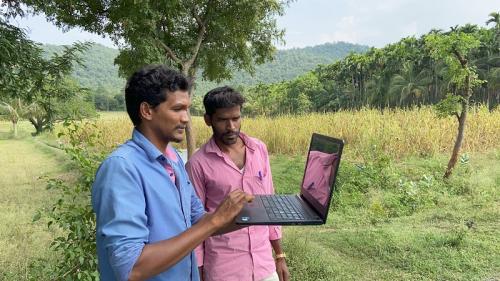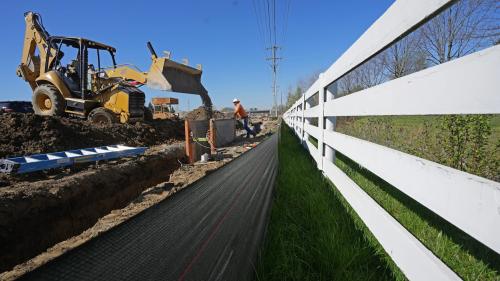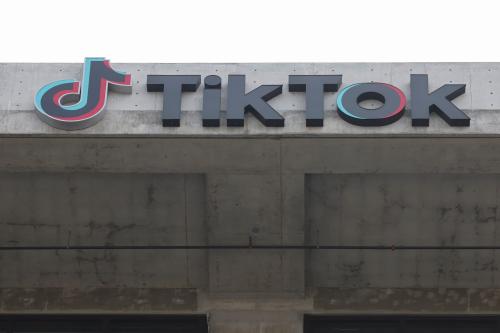Millions of Americans could be affected by thousands of miles of toxic telephone cables, a July 9 Wall Street Journal investigation has warned. These old cables, legacies from the pre-internet dial-up telephone era, are sheathed in lead, an element found to be toxic in humans. The report tumbled telecom company stocks to record lows and started a debate about both the science and what to do about these cables, some of which date back over half a century. We are both former officials of the Federal Communications Commission (FCC). In our time at the Commission and other telecom-related activities, neither of us ever heard concerns about lead sheathing, other than as a workplace safety issue. As former regulators, however, we recognize the challenges created by this development, the need for timely guidance to consumers and companies, and the potentially overlapping jurisdiction of federal agencies. Cost estimates to remediate the problem for the entire industry are settling in at between $4 and $20 billion. To put that number in perspective, the total capital expenditures of Verizon and AT&T were each around $20 billion in 2022. Ultimately, the federal government will have to resolve the complex scientific and legal issues of toxic telephone cables, the prioritization of remediation, and how it is paid for.
What exactly is this all about?
From the late 1800s to the 1960s, it was common practice to shield the copper wires inside telephone cables from electromagnetic interference by sheathing the cables in lead. It is believed the cables remaining today with this coating are mostly distribution cables for trunk lines rather than the lines that go into a home or office. These cables are either aerial deployments on utility poles, buried in the ground either directly or in conduits, or under water. A recent court filing by AT&T estimated that approximately 10% of its two million miles of copper wires are sheathed in lead. The company said about two-thirds of its lead-covered cables are “either buried or in conduit” followed by aerial cable, and a “very small portion” running underwater. Analysts estimate that about 25% of those 200,000 miles of cable are aerial, 63% is buried in conduit, seven percent buried directly without the protection of conduit, and the remaining five percent is under water. The level of health and safety risks depend on how the cables are deployed. One theory holds the risk associated with cables contained inside buried conduits is different from cable buried directly in the ground or cable hung from poles. This, coupled with how removing the cables may release lead, suggests the need to prioritize sites of remediation that also take into consideration issues such as proximity to schools, playgrounds, hospitals, and other areas containing vulnerable individuals. In short, the initial first step is to map where and how the lead cables are deployed and then prioritize the various types of installations for remediation, if necessary.
Science and law
The industry’s trade association, USTelecom, has created a website, “Telecom Cable Facts,” to represent the industry on the issue. The industry says that it has complied with all applicable laws and regulations on the matter. Beyond legal compliance, the industry asserts, “We have not seen, nor have regulators identified, evidence that legacy lead-sheathed telecom cables are a leading cause of lead exposure or the cause of a public health issue.” After the Wall Street Journal article, three environmental groups formally requested that the Environmental Protection Agency (EPA) “investigate the uncontrolled release of lead into the water or surface soil from more than 2,000 lead-sheathed telecom and power cables across the nation.” The request noted, “Without EPA intervention, we expect that the risk posed by the cables will increase as they further deteriorate and release lead into the environment.” At the heart of the matter are differing scientific opinions. “We feel strongly that The Journal’s reporting conflicts with what independent experts have long stated about the safety of lead-clad telecom cables and our own environmental testing,” AT&T CEO John Stankey wrote in a memo to employees. “Based on our repeated testing of these cables–data and methods we have made publicly available–we have serious doubts with the Journal’s testing methods and the reliability of its results and reporting,” AT&T said in a court filing about the lead cables in Lake Tahoe that were featured in the story. Differing interpretations of science and facts typically lead to years of litigation. Environmental litigation similarly can result in years of courtroom activity. As if the debate over science and testing isn’t enough, the chain of ownership of telecom cables is long and confusing. The breakup of AT&T in 1984 began a reshuffling of who owns what, the assignment of potential liability in those circumstances also opens the door to litigation. If the science and ownership liability are going to be debated and ultimately litigated, the matter will drag on unresolved for years.
Who leads on lead?
While the first steps of mapping and prioritization, are obvious, the question of who leads is not. New York State has already jumped ahead, requiring all the telcos operating in the state to provide it with a full inventory of lead-affected cables within 30 days. Other states are likely to follow and such information will provide important to addressing health issues. But ultimately, we think only the federal government has the combination of skills and resources to orchestrate an acceptable resolution. As evidenced by the letter from the environmental groups, the EPA will be a major locus of the federal regulatory discussion. It has the requisite scientific expertise and track record to analyze the risks, compel action and issue penalties. That filing, however, pointed out, “We recognize that lead-sheathed telecom and power cables were not identified in EPA’s 2022 Strategy as a source of lead exposure.” The FCC also has a role. Title I, Section 1 of the Communications Act makes the FCC responsible for “promoting safety of life and property” in matters related to telecommunications activities. Referencing the New York action, Chairwoman Jessica Rosenworcel said, “We want to discuss with them what their plans are and want to figure out how we can assist them going ahead.” While the FCC is not a scientific agency, it does have the ability to demand information from the companies, such as their data regarding previous testing as well as the location of lead sheathed cables. The Occupational Health and Safety Administration (OSHA), a part of the Department of Labor, also has jurisdiction over worker safety. The Wall Street Journal coverage included stories of telephone company employees asserting their health was affected by working with lead cables. But nothing prevents the three agencies from working together. They should immediately form a joint task force with the goal of providing a map and site prioritization within 60 days. Indeed, one would hope the Administrator of EPA, Chair of the FCC, and Assistant Labor Secretary responsible for OSHA, along with the White House are already coordinating such a response. One only must recall the failure of the Trump administration’s FCC and Federal Aviation Administration (FAA) to coordinate on 5G deployment and aircraft safety systems to understand the importance of such joint decision making. Presumably, such inter-agency cooperation could provide guidance on exposure risks and remediation strategies.
Who pays?
As the mapping and prioritization is developed, there also must be a plan to pay for the remediation. There are three sources of funding: shareholders, ratepayers, and taxpayers. Forcing shareholders to pay will be time-consuming and has limited potential for success. Differing interpretations of science and facts, including environmental litigation, typically lead to years of courtroom activity. As discussed earlier, the chain of ownership of telecom cables is less than straight forward thanks to previous teleco breakups. The assignment of potential liability also opens the door to litigation. Looking to shareholders to pay for remediation that may be needed immediately will be a challenge amidst the companies’ “we obeyed the rules” defense and determining just who has the liability for what old plant. If speedy remediation is a goal, these issues will be headed to court and will no doubt delay action. Assessing rate payers is also tricky, especially when the Biden administration is on a campaign to reduce user fees. In addition to such a fee’s impact on the policy goals of keeping broadband affordable, there are competitive issues in assessing the phone companies but not their competitors, and fairness in assessing competitors such as cable broadband for problems they had nothing to do with. There is the possibility that the issue could be resolved in the context of what all acknowledge is a need to reform the FCC’s Universal Service Program. But counting on that possibility seems unwise. In the current context of budget debates, the notion of taxpayers paying for the remediation may also seem unlikely, but it is the most likely path to at least accelerate the remediation those locations where the lead presents a clear immediate or near-term danger. There are funds for environmental remediation in the Inflation Reduction Act of 2022 that might be tapped for the highest priority projects. At least a dozen states are likely to have more than enough funds to connect unserved and underserved locations and, with waivers from the Department of Commerce, could use those excess funds for remediation. Further, there may be some overlap between the unserved and underserved locations and areas with lead where the broadband funding could efficiently serve both purposes. There is precedent for federal funding to replace telecommunications networks that in retrospect created unacceptable risks. At the direction of Congress, the FCC is currently administering a $1.9 billion program to reimburse small providers of advanced communications services for removing and replacing equipment provided by Chinese companies. While that program has been underfunded, it provides a model for addressing common practices that in the fullness of time created risks that America broadly wants to be eliminated. Thanks to the $42.45 billion federal subsidy program of the Commerce Department to extend broadband networks into unserved areas we are close to the day where we can declare the access digital divide finally closed. Funding such an effort to build tomorrow’s network, however, while ignoring potential toxicity in yesterday’s network seems politically unsustainable. At the same time, adding billions of dollars of remediation expense to company capital expenditures could have a negative effect on the companies’ ability to invest in broadband and maintaining a competitive and affordable broadband market. To address both the health needs and the broadband needs efficiently and quickly, we need the federal government to map, prioritize and fund the solutions.
-
Acknowledgements and disclosures
Verizon and AT&T are general, unrestricted donors to the Brookings Institution. The findings, interpretations, and conclusions posted in this piece are solely those of the authors and are not influenced by any donation.
The Brookings Institution is committed to quality, independence, and impact.
We are supported by a diverse array of funders. In line with our values and policies, each Brookings publication represents the sole views of its author(s).









Commentary
Toxic lead telephone lines: Searching for solutions
July 28, 2023